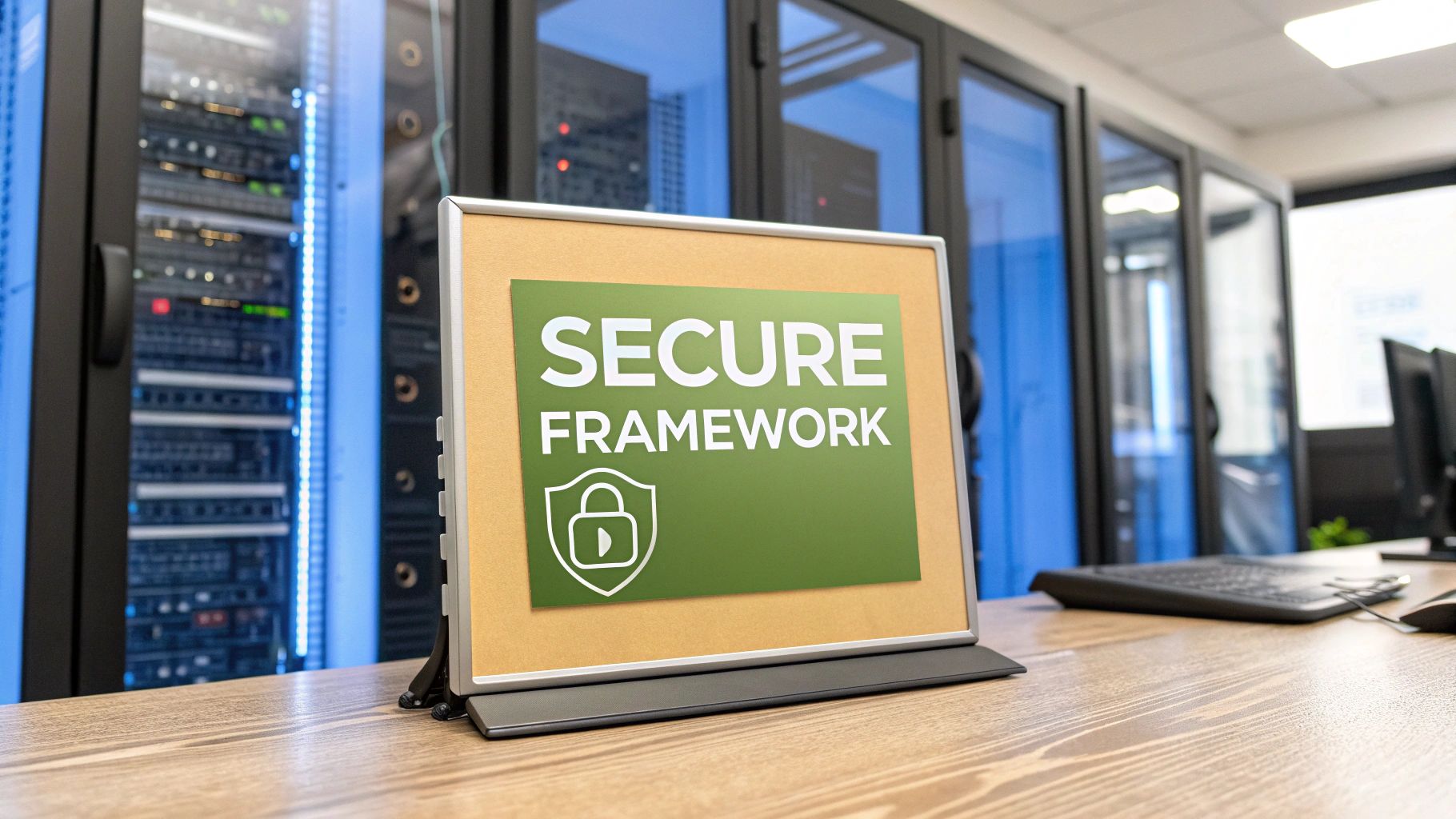A cybersecurity risk assessment framework is basically a structured game plan for managing digital risk. Think of it as a playbook you can use over and over again for your security strategy. It’s what helps you move from just reacting to problems to building a smart, organized defense for your clients.
At its core, a framework gives you the guidelines and best practices needed to protect your clients' important data. It’s the blueprint for building a security program that makes sense. For MSPs, vCISOs, and GRC companies, this organized approach is how you deliver consistent and effective security services every single time.
This structure also gives you a simple way to talk about complex risks with clients who aren't tech experts. It makes it much easier to explain why services like manual pentesting are necessary to prove that their security controls actually work. Our team of OSCP, CEH, and CREST certified pentesters provides this validation quickly and affordably.
Understanding the Core of a Security Framework
Imagine trying to build a house without a blueprint. The final result would be unstable and unsafe. A cybersecurity risk assessment framework is that essential blueprint for your client's entire security program, turning vague goals into a clear list of actions.
Frameworks are built around five core functions that create a continuous loop for managing cyber threats. Here’s a simple breakdown of what each one means for you and your clients.
The NIST CSF provides a clear, five-step playbook for managing security, which is perfect for MSPs and vCISOs. First, you Identify your client’s most critical assets and the biggest business risks tied to them. Next, you Protect those assets by putting core safeguards in place, like access controls and employee training. The third step is to Detect threats by setting up monitoring to spot weird activity as soon as it happens. When a breach occurs, the Respond function is your action plan, outlining the steps to quickly contain the incident. Finally, Recover guides you in restoring any lost services and ensures you learn from the incident to get your client back to business quickly.
These five functions work together to create a full risk management cycle, giving you a structured way to improve a client's security from the ground up. This approach is key for meeting compliance standards like SOC 2, ISO 27001, HIPAA, and PCI DSS.
Choosing the Right Cybersecurity Risk Assessment Framework

Picking a cybersecurity risk assessment framework can feel overwhelming with all the options like NIST CSF, ISO 27001, and CIS Controls. The key is to find the right tool for the job. Your goal as an MSP or vCISO is to match the framework to your client's needs, like their industry, size, and compliance requirements.
This infographic shows how risk analysis fits into a larger business strategy. A good framework helps you connect the technical details to what the business actually cares about.

Let's break down the big three frameworks you'll see most often. This table breaks down their main focus and who they're best for, helping you pick the right fit for your clients.
You can't sell every client the same security solution, which is why understanding the different compliance frameworks is critical.
The NIST CSF (Cybersecurity Framework) is your go-to for risk management and communication, acting like a flexible security playbook perfect for U.S. organizations. It excels at showing how technical security work directly connects to business goals, which is key to proving your value.
In contrast, ISO 27001 is the choice for clients needing a formal Information Security Management System (ISMS). This powerful certification acts as a globally recognized sales tool, proving a serious commitment to security.
Finally, the CIS Controls are perfect for SMBs or organizations just starting out, offering prioritized technical controls. They provide a simple, actionable plan that makes it easy to show quick, measurable security improvements right away.
To make the final call, ask a few simple questions. Are they in a regulated industry? Do they need to meet compliance rules like PCI DSS or SOC 2? If a client is dealing with HIPAA, the NIST CSF is a great roadmap. If they just need to lock things down for PCI DSS, the CIS Controls offer a direct path.
How Your MSP Benefits from a Formal Framework
Running a security service based on guesswork doesn't work anymore. Using a formal cybersecurity risk assessment framework is what separates professional security providers from the rest. It helps you build a repeatable and predictable security program for every client.
A framework gives you a standard playbook, making your whole operation more efficient and ensuring every client gets the same high level of protection. One of the biggest challenges for any MSP or vCISO is explaining complex security risks to clients. A framework gives you a structured, common language that makes these talks much easier.
Instead of talking about vague threats, you can point to specific controls in a recognized standard. This helps clients see what you're doing and why it matters. When you show how a service like manual pentesting maps to a control in their framework, the need for it becomes obvious.
A formal framework also helps reduce your own liability. By following established industry best practices, you can show you took reasonable steps to protect your client's assets. This is critical if a security incident ever happens. It also helps you scale your security services, letting you build tiered packages and streamline your delivery.
Why You Must Validate Your Security Framework

A cybersecurity risk assessment framework is your plan, but how do you prove it actually works against a real attacker? That's where penetration testing comes in. It's like a fire drill for your client's digital security, testing your defenses under real pressure.
Implementing controls from a framework like NIST or ISO 27001 is a great first step. But without validation, you're just hoping it all works. A pentest shows you the reality by actively trying to exploit weaknesses just like a real hacker would. This is essential for compliance with standards like SOC 2, HIPAA, and PCI DSS, which require proof that your controls can stop an attack.
We know that traditional penetration testing has been a major headache for resellers due to inflated prices and long wait times. We built our company to solve this industry problem. We are a channel-only partner, meaning we work exclusively through partners like you and never compete for your clients.
We offer affordable, fast, and completely white label pentesting services. Your client gets a high-quality report with your brand on it, and you provide a critical service without the usual issues. Our team of certified experts—with certifications like OSCP, CEH, and CREST—performs manual pentesting to find the vulnerabilities that automated scanners miss. You get a clear, actionable report back in days, not months.
Creating a Scalable Cybersecurity Risk Assessment Service
For an MSP or vCISO, the real opportunity is turning risk assessments into a profitable, scalable service. This is how you become a strategic partner instead of just a reactive problem-solver. It starts with understanding your client's business, their critical assets, and their compliance needs, whether it's HIPAA, SOC 2, or PCI DSS.
The assessment itself is just the beginning. The real value is in the report you deliver afterward, which should connect security risks to real-world business impact. This report becomes your roadmap for laying out a prioritized list of fixes and improvements, creating opportunities for recurring revenue.
A scalable service is built on efficiency and consistency. Using a cybersecurity risk assessment framework gives you a template for every engagement, saving you time and ensuring every client gets the same high-quality service. This repeatable model also makes it simple to integrate validation services.
Our affordable, white label pentesting plugs right into this process. As a channel-only partner, we deliver fast, manual pentesting from our OSCP, CEH, and CREST certified experts. You can offer this critical validation under your brand, prove your roadmap's value, and strengthen your client relationships. This is a key part of any complete threat and vulnerability management program.
Get Affordable and Fast Security Testing Today
Putting a cybersecurity risk assessment framework in place is a great start, but your clients need to know if it actually works. Proving your security strategy is solid is what separates a good MSP from a great one, and that's where we come in. We are a channel-only, white label pentesting provider built to fix the industry's problems of slow service and high costs.
You're the expert at building security programs; we're the experts at testing them. We deliver fast, affordable, and thorough manual pentesting that you can sell under your brand. Our team of OSCP, CEH, and CREST certified professionals becomes an extension of your own, finding real-world vulnerabilities that automated scanners miss.
We are a true partner, not a competitor. Our channel-only model means we are 100% focused on your success. You get to provide the expert validation your clients need for compliance with SOC 2, HIPAA, and PCI DSS while you maintain the trusted client relationship. We help you win and keep more business by making high-quality security validation an easy and profitable part of your services.
Contact us today to learn how our affordable, fast, and white-labeled penetration testing can help you grow your business.


.avif)
.png)